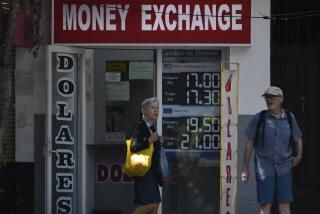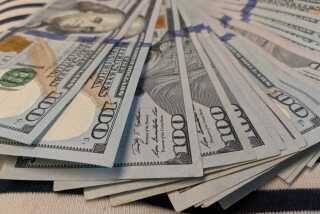The Buck Hops Here : The Punchy U.S. Dollar Is Flying High in Canada
QUEBEC CITY, Canada — While an American tourist in Paris these days might find the restaurant tab for le menu de degustation worse for the heart than a double dose of cholesterol, in this French-accented city just north of the U.S. border, the bill could tempt you to indulge in a second dessert.
The U.S. dollar may be punchy in Europe and Japan, but it still packs its old wallop in Canada.
The Canadian dollar has hovered near 72 cents for about three months now, down four cents from the beginning of the year, six cents from a year ago and 11 cents since mid-1989. Analysts here predict it will decline even more, perhaps matching the all-time low of 69.2 cents, struck in February, 1986.
While this may not be great for Canadian pride--or interest rates--it’s not entirely bad for business here. Because the two economies are so closely tied--nearly 80% of Canada’s trade is with the United States--the weakening Canadian dollar has created opportunities for Canadian exporters, U.S. companies that manufacture goods in Canada and the tourism industry.
“Although the U.S. dollar has been battered by the major currencies, it does much better against the Canadian dollar, and that’s likely to continue,” said Robert Palombi, an economist with MMS International, a Toronto consulting firm.
He and other analysts project a continued downward trend for the Canadian dollar based on uncertainty surrounding an upcoming provincial election in Quebec--the Parti Quebecois, dedicated to Quebec independence, is leading in the polls--and Canada’s high public debt.
Canada has been following the United States out of recession this year, and the newest government figures, reported last week, show that the Canadian economy grew by 0.3% in April, fueled largely by record exports, particularly of automobiles. While manufacturing and trade grew, retailing was off slightly, reflecting some nervousness about higher interest rates. The prime rate jumped to 8% from 5.5% between February and June. The gap between U.S. and Canada interest rates also has grown.
For most Americans, however, the most noticeable effect of the widening currency exchange rate is to make Canada a much more attractive vacation destination. With the summer tourism season just getting underway in earnest in Canada, the buses are lining up outside the landmark Chateau Frontenac hotel here, and rivers of tourists flow through the narrow streets of the walled old town.
After nearly four years of recession, the tourism industry here looks forward to a surge of U.S. visitors.
Quebec innkeeper Valerie Andree Authier recently returned from a meeting with U.S. travel agents, where she emphasized the favorable exchange rate. Authier’s inn, the 27-room La Pinsonniere, on the scenic Charlevoix coast of the St. Lawrence River east of Quebec City, is a member of the exclusive Relais & Chateaux group of resorts and restaurants, and doesn’t exactly cater to bargain-hunters. Guests pay up to $180 a night U.S. ($250 Canadian) for a premium room, and more if gourmet meals are included.
But Authier’s sales pitch is that La Pinsonniere is far more reasonable for American visitors than similar upscale inns just south of the border. She is careful to explain the exchange rate to American callers and says that even in this price bracket, “it certainly does have an impact . . . . You’re always trying to take advantage of a better exchange rate.”
Hope McCatty, owner of the 23-room Dutch Inn ($39.60 U.S. per night, $55 Canadian) in Niagara Falls, Ontario, is on a similar campaign. She doesn’t think enough is being done to promote Canada as a destination.
“We don’t advise the Americans enough that their dollars make Canada a good vacation,” she said. “I always mention it when I talk to Americans on the phone, but we have to do more.”
David Redekop, director of the Canadian Tourism Research Institute in Ottawa, said that in the first four months of 1994, trips of one night or more by Americans to Canada were up 5% over the same period last year.
“That’s a trend we expect to continue,” Redekop said. “We expect a 5% to 6% increase this year; in April alone it was up 6.2%.”
The institute’s research shows that the exchange rate was a significant factor in the increase, he added. At the same time, Canadians are staying home; visits to the United States were down 10.6% through April.
John Hamilton, manager of communications for the Metropolitan Toronto Convention & Visitors Assn., said research on travel motivation shows that value is a secondary concern when selecting a vacation spot, but may play more heavily into a decision about how to spend money once a tourist arrives.
“People don’t select a destination first and foremost because it’s a bargain,” he said. “It almost always is driven by having friends and family in the area or by things you want to do, such as go to museums. . . . Cost is not a primary motivator, but it’s part of the equation.”
Similarly, the favorable exchange rate has a contributing, but secondary, effect on other businesses.
Take the automobile industry. “It’s now an awful lot cheaper to build a car in Canada than the United States,” said Robert Fairholm, chief economic forecaster for DRI Canada. “They pay their workers in low Canadian dollars and sell the cars in the United States for U.S. dollars.”
Last year, nearly 2.24 million vehicles were manufactured in Canada, half of them for export, according to DesRosiers Automotive Consultants Inc. of Toronto.
“Canada is the best spot in North America, if not the world, to manufacture vehicles,” said Dennis DesRosiers, who heads the firm. But the principal reason it is less expensive to manufacture here, he said, is the lower cost of health care for employees. Canada guarantees care for all under a tax-paid system administered by federal and provincial governments. The exchange rate is “a significant bonus,” DesRosiers said.
Canada’s provincial film boards also factor the exchange rate into their aggressive courting of Hollywood productions. Vancouver and Toronto are well established movie-making centers; Viacom recently announced it will produce 12 to 15 films, at a cost of $50 million, in Toronto over the next 12 months for its Showtime cable network. And this summer, cameras are rolling on Stephen King’s “Dolores Claiborne” and on “The Scarlet Letter,” starring Demi Moore, in Nova Scotia, which until last year had never hosted a major movie shoot.
“Producers always look at the bottom line, so when you get a spread (in the exchange rate) like we’ve had lately, it certainly helps,” said Helen Wickwire Foster of the Nova Scotia Film Development Corp.
But the drooping Canadian dollar also means trouble for some businesses. Consider the Toronto Blue Jays. Baseball’s two-time defending World Series champions pay their players (estimated payroll $40.5 million) and most other costs in U.S. dollars. But the bulk of their revenue is in Canadian dollars. So, every one-cent decline of the Canadian dollar costs the club about $850,000, according to Howard Starkman, director of public relations.
Where the Dollar’s Strong
The U.S. dollar has been falling in Europe and Japan but is still strong in Canada. The U.S. dollar in Canadian dollars, quarterly closes, except latest:
Wednesday: 1.3883
Source DRI Canada
*
Researcher Andrew Van Velzen in The Times Toronto bureau contributed to this story.
* SOUTH OF THE BORDER: The greenback is formidable in Mexico too. D2
More to Read
Inside the business of entertainment
The Wide Shot brings you news, analysis and insights on everything from streaming wars to production — and what it all means for the future.
You may occasionally receive promotional content from the Los Angeles Times.









